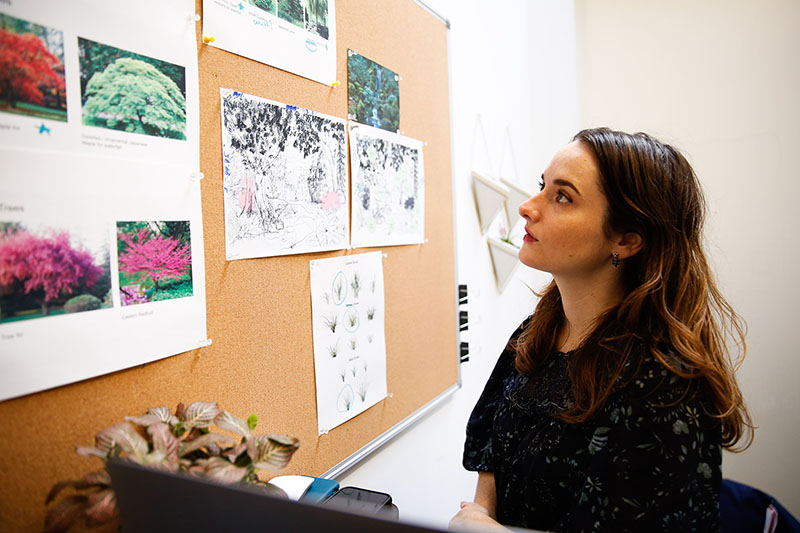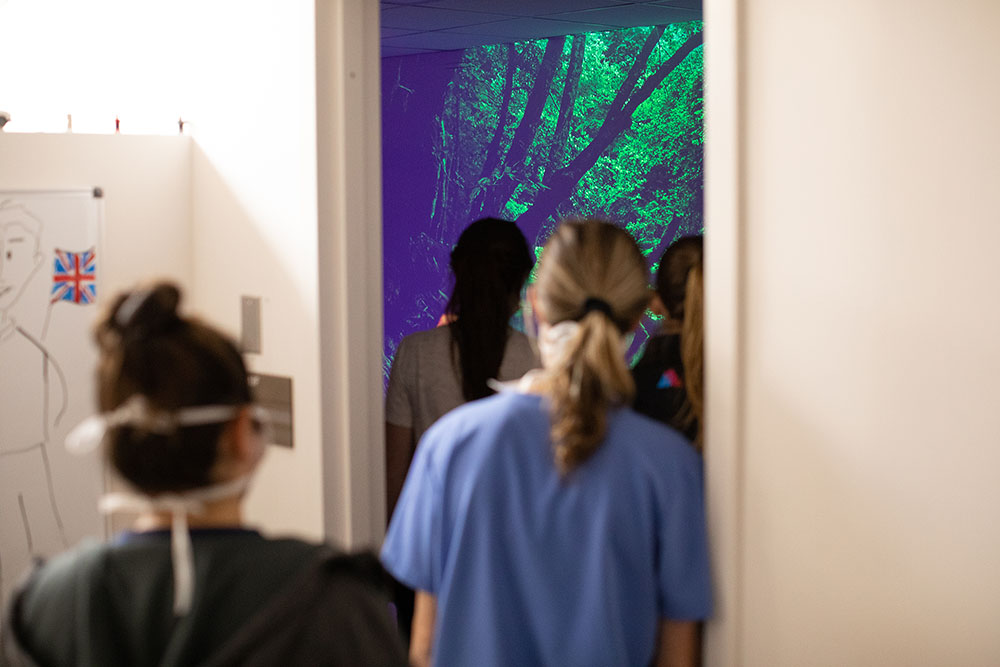PROFILE
Immersive Environments to the Rescue
Mirelle Phillips designs spaces to ease the mind, accelerate healing, and generate awe.
Sometimes, you just have to build what others can’t see.
Last spring, New York City became the epicenter of the COVID-19 pandemic, and the city’s hospitals were in full crisis mode. On March 23, New York-based designer Mirelle Phillips wrote in her diary, “New York City had 12,231 COVID-19 infections, 1,600 hospitalizations, and 157 dead.”
Frontline health care workers were dying. They were heroically tending to the sick, Phillips thought at the time, but who was tending to them? Her design company, Studio Elsewhere, was perfectly positioned to help. Their work applies biophilic design and supportive design theory principles to “open-world” game environments to transform ordinary rooms into serene healing spaces. (An open-world game environment is a digital space designed to allow the visitor to roam freely in many directions.) While staying grounded in clinical research, Studio Elsewhere uses light, sound, and scent to create mixed and augmented reality environments enlivened by the work of collaborating artists. So Phillips began designing restorative rooms where the doctors, nurses, and other staff could recharge at Mount Sinai Hospital, a 175-year old hospital sandwiched between Central Park and the Harlem River in Upper East Side Manhattan.
At the time, she was working on a project with Helen Mayberg, a renowned neuroscientist doing pioneering work on deep brain stimulation for treatment-resistant depression. Their collaboration, a new project called Qlab, was a first-of-its-kind interactive laboratory for mood and motor disorder patients intended to incubate groundbreaking research using biometric data capture, interactive technology, machine learning, and AI.
Mayberg remembers the first time she met Phillips and was able to see her creative process in action. She was working on a project she spearheaded for a client whose stroke left him mentally intact but able to communicate only with his eyes and a single finger. Phillips transformed a lab space into an immersive room that allowed family members and the patient to control the environment entirely through voice and tap.

“Mirelle envisioned, designed, built, and installed a unique immersive world of sounds, smells, colors, and memories; a room that was transformative for both the patient and his family,” Mayberg says. “She had asked the patient’s family about landscapes that felt safe and restorative, and Sitges, Spain came up as a place he’d lived.” After researching the region, Phillips, inspired by the grotto churches and stunning cliffs, designed a sculpture reminiscent of both the cliffside and the cave so that the patient would have a textural view framed from his bed. Also inspired by that region’s flora, she collaborated with botanical artist Fernando Kabigting on creating the floral and plant installation. “She captured her profound appreciation of the fragility of the human condition,” says Mayberg. “Her capacity to integrate design, aesthetics, technology, and functionality to create a space that is practical and therapeutic was breathtakingly beautiful and enriching.”
To date, the immersive spaces designed by Mirelle and Studio Elsewhere have provided respite to more than 200,000 health care workers.
Awakening at an orchid show
Like many creative types who wend their way into medicine from other fields, Mirelle Phillips’s professional foray into health care design began with a personal health crisis. While in her late twenties, working as the head of experiential design for a video game company, a tragic fall led to months in and out of hospitals and rehab, seeing specialists whose various treatment plans often contradicted one another. Confined to a wheelchair, she was reduced to a world consisting of her bedroom and the hospital. Worse, the painkillers required to manage her pain left her feeling like a zombie. Not surprisingly, her mental health deteriorated.
The turnaround came one winter morning when her sister took her to the New York Botanical Gardens Orchid Show. As her sister wheeled Phillips through the experience, a massive orchid display held her attention. She gazed in awe and silence. Even though she couldn’t name it back then, the experience was transformative, and for the first time since her injury, she felt a sense of connection.
Soon Phillips was drawing nature-filled imaginary environments from her bed. Pain felt like a booming speaker in her brain, but when experiencing the great outdoors, a beautiful indoor space, or even an immersive game world, her mind settled. “The virtual reality headset-based treatments that were part of my rehab made me think about what healthy immersion could look and feel like,” says Phillips. A year and a half after her injury, she founded Studio Elsewhere. And now she’s putting that experience to work as the pandemic has created more need for her brand of immersive spaces than ever before.
David Putrino, director of rehabilitation innovation for Mount Sinai, worried his colleagues might fall prey to Directed Attention Fatigue (DAF), which can often result in cognitive difficulties and performance variability. His co-workers were faced with multiple stressors, from school closures to loss of childcare to fear of contracting COVID-19 and spreading the virus to their families. In the darkness of the first wave of the pandemic last year, as critically ill patients surged into hospitals already operating above capacity, he called upon Phillips and her Studio Elsewhere team.
“Space is never neutral. It either harms, or it helps, but it never does nothing to your physiology.”
Phillips had been developing a recharge room for the Brooklyn Nets pro basketball team before the pandemic, so with the interruption of live sports, she pivoted her team to transform a 3,000-square-foot underutilized research space in the sub-basement of Mount Sinai into a frontline relief hub—a center for reprieve. The only problem was, she had no funding.
The first thing most people notice about Phillips is an intensity fueled by an urgency to help those that are suffering. After calling contacts for donations, Phillips says, “Asking for money led to so many more questions and endless analysis from those who have the privilege of debating instead of understanding the depth of the crisis.” Knowing there was no time to waste and that she was the only one who could envision what she was building, she went all-in on her mission. She decided to use personal savings to fund the first interactive, voice-activated recharge room.
First Phillips reached out to EMBC, a studio lab focused on interdisciplinary artistic production founded by Jacob Marshall and his partner Hae-jin, to compose musical experiences for the recharge rooms. Tim Fain, an award-winning violinist best known for his work with Philip Glass and for his musical contributions to the films Black Swan, 12 Years a Slave, and Moonlight, once performed at the Vatican for the Dalai Lama. Working with EMBC, he says, “This past year has been inspiring me to create with the intention of dedicating the music to the people who need it most.”
Echoes of past terror in Manhattan
The pandemic helped us realize that health care workers are not a renewable resource. It also provided a spotlight on mental health needs like never before. On April 26, 2020, Lorna Breen, the emergency room director at New York-Presbyterian, another Manhattan hospital on the frontlines of treating COVID-19, committed suicide. The devastating loss rippled through the health care community, drawing attention to the mental anguish of health care workers. Many recalled a familiar time—9/11.
Breen’s tragic death pointed to “moral injury” as a risk factor. Moral injury is the damage done to one’s conscience or moral compass. Distinct from post-traumatic stress disorder, “moral injury” is a term that Brett Litz of Boston University and his colleagues modified in 2009 to encompass the psychic fallout resulting from when a person perpetrates, witnesses, or fails to prevent acts that transgress one’s own moral beliefs, values, or ethical codes. Researchers studying moral injury in times of COVID-19 report that health care providers face an increased risk of moral distress during the pandemic because of changes in clinical practice forced by resource constraints. Clinicians have had to make life-and-death decisions which are inconsistent with the normal standard of care, driven by the fact that resources are scarce. This is painful and distressing.

Phillips remembers the early pandemic surge at Mount Sinai. Hundreds of patients were flooding the hospital as innumerable body bags were being wheeled out. Her team became a crisis design, tech, and operations hub within the hospital. Putrino, meanwhile, was building upon a growing body of research to analyze the new, immersive environments. He published a study revealing a 60 percent stress reduction after just 15 minutes in their multi-sensory immersive recharge room—a crucial finding for maintaining support and momentum. Phillips pushed the therapy further by intentionally designing spaces for multiple participants. “I can’t overstate the power of group sessions,” Petrino says.
“Mount Sinai has been about as supportive as a large health care system can be with this initiative,” Putrino says. “They doubled down on building more infrastructure around the recharge rooms and installing more rooms to more hospitals. However, from time to time, I butt up against the ‘return on investment [ROI]’ question: what is the hospital’s ROI for these extremely expensive rooms? In the world of innovation, you do things in response to what the community is asking for, not because of return on investment,” he says. “If we want to be thought leaders, we need to fully commit.”
“Every leading corporation acknowledges one universal truth: Space is never neutral. It either harms, or it helps, but it never does nothing to your physiology,” he adds.
This March, one year after the onset of the pandemic in New York, Phillips and her team installed nine new recharge rooms. Thanks to a grant from Barclays, Studio Elsewhere is partnering with the Greater New York Hospital Association to install recharge rooms in 15 public New York City hospitals that serve people regardless of their insurance.
The era of immersive health is upon us and Mirelle Phillips and her team at Studio Elsewhere are just getting started. She recently began the installation of the Charles Lazarus Children’s Ability Center, an immersive space for children with neurodisabilities where kids can create their own emotional support creatures who can act as personal avatars, guiding them through interactive forests and ethereal, nature-inspired environments during their treatments. Gone are the days of the traditional waiting room.
“We know that visiting a hospital can be quite nerve-wracking and stressful for the entire family,” says Phillips. “At the Lazarus Center, we’re inspired by the experience of video games as well as pop-up books, where the experience unfolds in a multi-dimensional way and there is a sense of agency and shared imagination patients and their families have with the environment.”
Asked about Mount Sinai’s recharge rooms, University of California, Berkeley psychology professor Dacher Keltner says, “Immersive spaces designed to elicit awe are an antidote to trauma because they change one’s sense of self to an awareness of being part of something larger than one’s concerns.” Poets, philosophers, and artists have long recognized the power of awe. However, it wasn’t until recently that psychologists like Keitner began studying the phenomena.
“Awe empowers sacrifice,” he writes in his upcoming book, Awe: A Journey into The Soul of Humanity, “even while giving up that most precious of resources, time.”
Editor’s Note: This story was updated on 5/14/21 to remove an incorrect description of an injury in the eighth paragraph.












